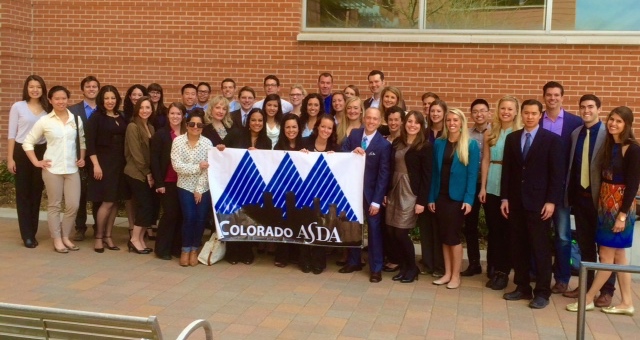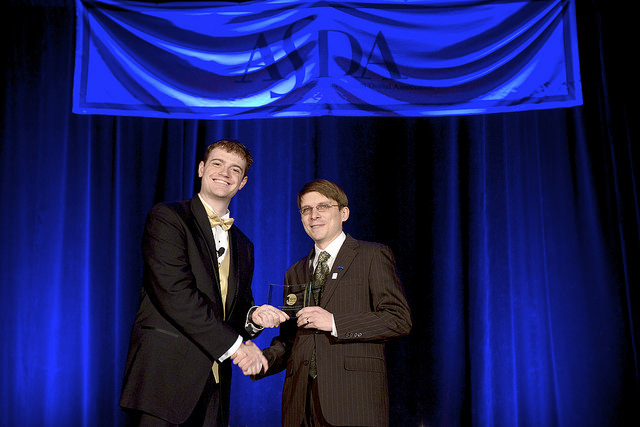 One sunny spring evening, I had the pleasure of attending a Colorado New Dentist Committee study club meeting focused on ‘success as a New Dentist in the first 5 years.’ We had the honor of listening to guest speaker Mark Bonnett of North Star Resource Group give a lecture on what it takes to start a practice or be a successful associate employee. What I found most interesting (due to its relevance to me as a current dental student) was his later focus on loan repayment, and managing finances once the big paychecks first start coming in.
One sunny spring evening, I had the pleasure of attending a Colorado New Dentist Committee study club meeting focused on ‘success as a New Dentist in the first 5 years.’ We had the honor of listening to guest speaker Mark Bonnett of North Star Resource Group give a lecture on what it takes to start a practice or be a successful associate employee. What I found most interesting (due to its relevance to me as a current dental student) was his later focus on loan repayment, and managing finances once the big paychecks first start coming in.
As soon-to-be dentists, the idea of ‘what the heck am I going to do after graduation?’ is a thought that weighs heavily on our minds. Sure, some of us will head to residencies (aka school forever), but for the rest of us, finding jobs right out of the gate is imperative as our student loans suddenly turn from Monopoly money into the real deal. After listening to Mark speak, one theme of his lecture became very clear: cash is king!
Since the day I signed my life away to the federal lenders, I had one thing in mind… “I’m going to pay these suckers off as quickly as possible.” What I came to realize in the first 5 five minutes of Mark’s lecture, is that this might not be the best thing to do. There are several alternatives all focusing around the idea that while we’ve amassed a large sum of debt, we should take our time in paying it off. Say you did choose to pay off your loans quickly by applying entire paychecks at a time to them. … What if you have an emergency? Or lose your job? Sure, you’ve got no debt… , but you’ve also got no money. The following are some suggestions for different ways to maximize your cash and minimize your loan payments:
Income Based Loan Repayment/Pay As You Earn Repayment
This is essentially setting your payments to correspond with your income:
Earn a lot --> pay a lot
Unemployed --> pay little (or even nothing.)
These programs are designed to base payments on income and family size, and payments are the same no matter how much you owe. Essentially, these programs are great for the dentist not making a lot of money because you’ll have more cash flow, rather than applying entire paychecks to student debts. A drawback of these programs is that while you’re not paying too much income into loans, you’re still collecting interest on every dollar that remains. That being said, if after 20 or 25 years (depending on the program) you haven’t paid off your loans, they are forgiven and your debts are eliminated! Too good to be true? Probably. The catch is that the amount forgiven is taxable, meaning that if $50,000 of your debt is erased, you will be expected to pay taxes on that in a lump sum amount. Should this be the route you choose to pay back your loans, make sure you’re saving setting some of your cash aside to pay this.
Public Service Loan Forgiveness
These programs are tied to income-based repayment programs but follow a different set of rules. In order to qualify you must work full-time for 120 months in a non for profit capacity- potentially in a setting that doesn’t pay well. Some residency programs can even count toward your time commitment, as long as they’re not-for-profit university or hospital programs. Basically most 501(c)3 (not for profit), state, federal (yes military counts) or academic opportunities could count. A benefit of the public service IBR is that the amount of debt forgiven is not taxed!
Consolidation
By consolidating your loans, you extend your payback window to 30 years, lowering your monthly payments. Consolidation also allows you to blend your interest rates, should you have some higher and some lower. A benefit of loan consolidation is that by lowering your monthly payments, you’ll have more cash flow. A couple drawback are that, once again, you’ll be collecting interest on those loans over the 30 years to it takes to pay them back. Also you could potentially be increasing your interest rate when the low rates are combined with higher rates for the weighted average. Keep in mind you can always pay the loans off early. Even if the loan repayment period is 30 years, there is nothing stopping you paying off the debt in 10 years or even sooner, once you get on your feet and have more stable cash flow.
(Some popular loan consolidation companies include SoFi and CommonBond, check these out if you're interested!)
After reviewing some of these loan repayment options, I hope you realize that there is no right or wrong way of paying back your loans. Every individual’s situation situation is different, and the pros and cons of each option should be reviewed before choosing which is right for you. The idea of lengthening your payment window stems from the idea that cash is king, meaning that having money set aside opens many doors for different options. When banks are deciding whether or not to loan you money for a house or a practice, they look deeply into your Debt : Income Ratio (This is the amount of monthly payments you are committed to make like credit cards, car payments, mortgages, etc., verses the amount of income you make on a monthly basis). By keeping your minimum payment lower, you have more flexibility to take on debts like a home or a practice. With this in mind, taking the time to pay back your loans while stashing away some funds will help you immensely when you’re trying to make a large purchase or investment.
After wrapping up discussion of loan repayment options and the idea of holding on to some of your debt in order to save money, Mark closed the lecture by answering a couple of FAQ’s questions proposed by the audience.
Q: Which loans should I pay off first?
A: Not considering consolidation? Put your money where the interest rates are higher, and pay those off first.
Is it smart to make large purchases even though I have a mountain of loans?
A: Historically speaking, it is not necessarily a bad time to be in debt. What does this mean? Interest rates are relatively low and will only go up from here. If you’re going to make a large purchase, such as a new car, it is smarter to finance it now that interest rates are low, rather than waiting until you have less debt and biting the bullet on higher interest rates.
Which comes first, the practice or the house?
A: It depends on how much debt you have, and what your debt:income ratio is. Banks are used to seeing dentists graduate with a massive accumulation of debt, take out a loan for a practice, then become successful and be able to pay the loans back. Purchasing a practice is more about the cash flow of the practice than your personal debt load. Banks look at Practice Loans differently than home loans because the practice produces income to pay the debt. Homes are just an expense, and thus the banks look at these types of loans only by looking at the strength of the borrower. If you have a bunch of practice debt, a mountain of Student Loan debt and minimal income because you started your practice in the last year or so, it will be more difficult to purchase a home.
More Information:
For more information on student loans and repayment options, check out the following resources:
If you've still got some questions, or would like to talk to Mark Bonnett himself, feel free to email him at Mark.Bonnett@northstarfinancial.com






 Being a great leader is something that each of us strives for. We all have a little bit of leader in us somewhere... we've always been driven for success, and we all hope to be our own bosses someday. We're all pretty responsible -- I mean, we had to be to get into dental school, right? -- but I think I'd be speaking for many of us if I said that the idea of being a
Being a great leader is something that each of us strives for. We all have a little bit of leader in us somewhere... we've always been driven for success, and we all hope to be our own bosses someday. We're all pretty responsible -- I mean, we had to be to get into dental school, right? -- but I think I'd be speaking for many of us if I said that the idea of being a 








 What was it like attending an ASDA conference for the first time? Well, it was AWESOME! In fact, “awesome” is exactly how ASDA Annual Session started out…
What was it like attending an ASDA conference for the first time? Well, it was AWESOME! In fact, “awesome” is exactly how ASDA Annual Session started out…